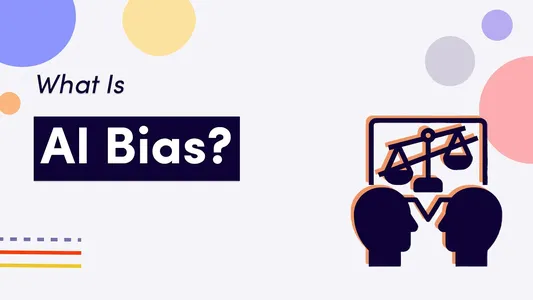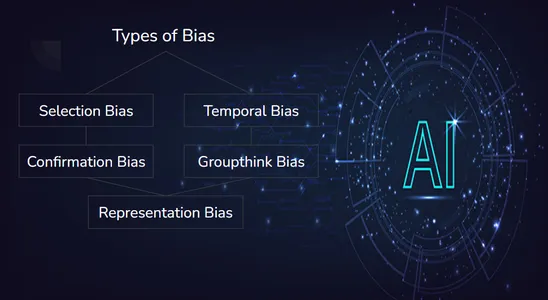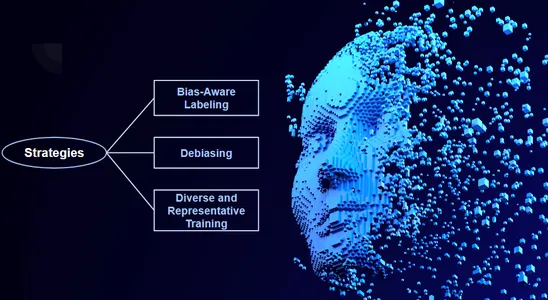Introduction
In today’s world, generative AI pushes the boundaries of creativity, enabling machines to craft human-like content. Yet, amidst this innovation lies a challenge – bias in AI-generated outputs. This article delves into “Bias Mitigation in Generative AI.” We’ll explore the types of bias, from cultural to gender, and understand the real-world impacts they can have. Our journey includes advanced strategies for detecting and mitigating bias, such as adversarial training and diverse training data. Join us in unraveling the complexities of bias mitigation in generative AI and discover how we can create more equitable and reliable AI systems.
Learning Objectives
- Understanding Bias in Generative AI: We’ll explore what bias means in AI and why it’s a real concern in generative AI, with real-life examples to illustrate its impact.
- Ethical and Practical Implications: Delve into AI bias’s ethical and real-world consequences, from unequal healthcare to trust issues in AI systems.
- Types of Bias in Generative AI: Learn about different forms of bias, like selection bias and groupthink bias, and how they manifest in AI-generated content.
- Bias Mitigation Techniques: Discover advanced methods like adversarial training and data augmentation to combat bias in generative AI.
- Case Studies: Explore real-world cases like IBM’s Project Debater and Google’s BERT model to see how bias mitigation techniques have been effectively applied.
- Challenges and Future Directions: Understand the ongoing challenges in bias mitigation, from evolving bias forms to ethical dilemmas, and a glimpse into future directions in addressing them.
This article was published as a part of the Data Science Blogathon.
Understanding Bias in Generative AI

Bias, a term familiar to us all, takes on new dimensions in generative AI. At its core, bias in AI refers to the unfairness or skewed perspectives that can emerge in the content generated by AI models.
This article will dissect the concept, exploring how it manifests in generative AI and why it’s such a critical concern. We’ll avoid jargon and dive into real-life examples to grasp the impact of bias on AI-generated content.
Code Snippet to Understand Bias in Generative AI
Here’s a basic code snippet to help understand bias in generative AI :
# Sample code illustrating bias in generative AI
import random
# Define a dataset of job applicants
applicants = ["John", "Emily", "Sara", "David", "Aisha", "Michael"]
# Generate AI-based hiring recommendations
def generate_hiring_recommendation():
# Simulate AI bias
biased_recommendation = random.choice(applicants)
return biased_recommendation
# Generate and print biased recommendations
for i in range(5):
recommendation = generate_hiring_recommendation()
print(f"AI recommends hiring: {recommendation}")This code simulates bias in generative AI for hiring recommendations. It defines a dataset of job applicants and uses a simple AI function to make recommendations. However, the AI has a bias, and it tends to recommend certain applicants more frequently than others, illustrating how bias can manifest in AI-generated outputs.
Ethical and Practical Implications
It’s time to confront the ethical and practical implications that come with it.
On the ethical front, consider this: AI-generated content that perpetuates biases can lead to real harm. In healthcare, biased AI might recommend treatments that favor one group over another, resulting in unequal medical care. In the criminal justice system, biased algorithms could lead to unfair sentencing. And in the workplace, biased AI could perpetuate discrimination in hiring decisions. These are not hypothetical scenarios; they are real-world consequences of biased AI.
In practical terms, biased AI outputs can erode trust in AI systems. People who encounter AI-generated content that feels unfair or prejudiced are less likely to rely on or trust AI recommendations. This can hinder the widespread adoption of AI technology.
Our exploration of bias in generative AI extends beyond the theoretical. It delves into the very fabric of society, affecting people’s lives in significant ways. Understanding these ethical and practical implications is essential as we navigate the path to mitigating bias in AI systems, ensuring fairness and equity in our increasingly AI-driven world.
Types of Bias in Generative AI

- Selection Bias: This type of bias occurs when the data used to train AI models does not represent the entire population. For example, if an AI language model is trained predominantly on text from one region, it may struggle to understand and generate content relevant to other regions.
- Representation Bias: Representation matters in AI. When the training data doesn’t adequately represent different groups, it can lead to underrepresentation or misrepresentation. Think about AI-generated images that depict certain demographics more accurately than others.
- Confirmation Bias: This bias occurs when AI systems inadvertently reinforce existing beliefs or stereotypes. For instance, an AI news aggregator might prioritize articles that align with a particular political view, further entrenching those beliefs.
- Groupthink Bias: In a group setting, AI models can sometimes generate content that aligns too closely with the dominant opinions within the group, suppressing diverse perspectives.
- Temporal Bias: AI models trained on historical data can inherit biases from the past, perpetuating outdated or discriminatory viewpoints.
By understanding these different types of bias, we can better identify and address them in AI-generated content. It’s essential in our journey toward creating more equitable and inclusive AI systems.
Bias Mitigation Techniques
- Adversarial Training: Adversarial training is like a game between two neural networks. One network generates content, while the other evaluates it for bias. This process helps the generative model become skilled at avoiding biased outputs.
import tensorflow as tf
# Define generator and discriminator models
generator = ...
discriminator = ...
gen_opt, disc_opt = tf.keras.optimizers.Adam(), tf.keras.optimizers.Adam()
for _ in range(training_steps):
with tf.GradientTape(persistent=True) as tape:
g, r, f = generator(...), discriminator(...), discriminator(generator(...))
gl, dl = ..., ...
gvars, dvars = generator.trainable_variables, discriminator.trainable_variables
tape = [tape.gradient(loss, vars) for loss, vars in zip([gl, dl], [gvars, dvars])]
[o.apply_gradients(zip(t, v)) for o, t, v in zip([gen_opt, disc_opt], tape, [gvars, dvars])]
In this code, Adversarial training involves training two neural networks, one to generate content and another to evaluate it for bias. They compete in a ‘cat and mouse’ game, helping the generative model avoid biased outputs. This code snippet represents the core concept of adversarial training.
- Data Augmentation: Diverse training data is key to reducing bias. Data augmentation involves deliberately introducing a variety of perspectives and backgrounds into the training dataset. This helps the AI model learn to generate content that’s fairer and more representative.
import nltk
from nltk.corpus import wordnet
from random import choice
def augment_text_data(text):
words = nltk.word_tokenize(text)
augmented_text = []
for word in words:
synsets = wordnet.synsets(word)
if synsets:
synonym = choice(synsets).lemmas()[0].name()
augmented_text.append(synonym)
else:
augmented_text.append(word)
return ' '.join(augmented_text)
This code snippet demonstrates a text data augmentation technique by replacing words with synonyms. It broadens the model’s language understanding.
- Re-sampling Techniques: Another approach involves re-sampling the training data to ensure that underrepresented groups get more attention. This helps in balancing the model’s understanding of different demographics.
from imblearn.over_sampling import RandomOverSampler
# Initialize the RandomOverSampler
ros = RandomOverSampler(random_state=42)
# Resample the data
X_resampled, y_resampled = ros.fit_resample(X_train, y_train)
This code demonstrates Random Over-sampling, a method to balance the model’s understanding of different demographics by oversampling minority groups.
- Explainability Tools and Bias Metrics: Explainability tools help understand AI model decisions, while bias metrics quantify bias in AI-generated content more accurately. Explainability tools and bias metrics are crucial for identifying and rectifying biased decisions. The code for these tools varies depending on specific tool choices and requirements but aids in making AI systems fairer and more transparent.
Fairness Metrics
Assessing bias in AI systems requires the use of fairness metrics. These metrics help quantify the extent of bias and identify potential disparities. Two common fairness metrics are:
Disparate Impact: This metric assesses whether AI systems have a significantly different impact on different demographic groups. It’s calculated as the ratio of a protected group’s acceptance rate to a reference group’s acceptance rate. Here is an example code in Python to calculate this metric:
def calculate_disparate_impact(protected_group, reference_group):
acceptance_rate_protected = sum(protected_group) / len(protected_group)
acceptance_rate_reference = sum(reference_group) / len(reference_group)
disparate_impact = acceptance_rate_protected / acceptance_rate_reference
return disparate_impactEqual Opportunity: Equal opportunity measures whether AI systems provide all groups with equal chances of favorable outcomes. It checks if true positives are balanced across different groups. Here is an example code in Python to calculate this metric:
def calculate_equal_opportunity(true_labels, predicted_labels, protected_group):
protected_group_indices = [i for i, val in enumerate(protected_group) if val == 1]
reference_group_indices = [i for i, val in enumerate(protected_group) if val == 0]
cm_protected = confusion_matrix(true_labels[protected_group_indices], predicted_labels[protected_group_indices])
cm_reference = confusion_matrix(true_labels[reference_group_indices], predicted_labels[reference_group_indices])
tpr_protected = cm_protected[1, 1] / (cm_protected[1, 0] + cm_protected[1, 1])
tpr_reference = cm_reference[1, 1] / (cm_reference[1, 0] + cm_reference[1, 1])
equal_opportunity = tpr_protected / tpr_reference
return equal_opportunityBias in Image Generation
In generative AI, biases can significantly impact the images produced by AI models. These biases can manifest in various forms and can have real-world consequences. In this section, we’ll delve into how bias can appear in AI-generated images and explore techniques to mitigate these image-based biases, all in plain and human-readable language.
Understanding Bias in AI-Generated Images
AI-generated images can reflect biases present in their training data. These biases might emerge due to various factors:
- Underrepresentation: If the training dataset predominantly contains images of specific groups, such as one ethnicity or gender, the AI model may struggle to create diverse and representative images.
- Stereotyping: AI models can inadvertently perpetuate stereotypes. For example, if a model is trained on a dataset that associates certain professions with particular genders, it might generate images that reinforce these stereotypes.
- Cultural Biases: AI-generated images can also reflect cultural biases in the training data. This can lead to images that favor one culture’s norms over others.
Mitigating Image-Based Bias
To address these issues and ensure that AI-generated images are more equitable and representative, several techniques are employed:
- Diverse Training Data: The first step is to diversify the training dataset. By including images representing various demographics, cultures, and perspectives, AI models can learn to create more balanced images.
- Data Augmentation: Data augmentation techniques can be applied to training data. This involves intentionally introducing variations, such as different hairstyles or clothing, to give the model a broader range of possibilities when generating images.
- Fine-Tuning: Fine-tuning the AI model is another strategy. After the initial training, models can be fine-tuned on specific datasets that aim to reduce biases. For instance, fine-tuning could involve training an image generation model to be more gender-neutral.
Visualizing Image Bias
Let’s take a look at an example to visualize how bias can manifest in AI-generated images:

In the above figure, we observe a clear bias in the facial features and skin tone, where certain attributes are consistently overrepresented. This visual representation underscores the importance of mitigating image-based bias.
Navigating Bias in Natural Language Processing
In Natural Language Processing (NLP), biases can significantly impact models’ performance and ethical implications, particularly in applications like sentiment analysis. This section will explore how bias can creep into NLP models, understand its implications, and discuss human-readable techniques to address these biases while minimizing unnecessary complexity.
Understanding Bias in NLP Models
Biases in NLP models can arise from several sources:
- Training Data: Biases in the training data used to teach NLP models can be inadvertently learned and perpetuated. For example, if historical text data contains biased language or sentiments, the model may replicate these biases.
- Labeling Bias: Labeling data for supervised learning can introduce bias if annotators hold certain beliefs or preferences. This can skew sentiment analysis results, as the labels might not accurately reflect the true sentiments in the data.
- Word Embeddings: Pre-trained word embeddings, such as Word2Vec or GloVe, can also carry biases from the text they were trained on. These biases can affect the way NLP models interpret and generate text.
Mitigating Bias in NLP Models
Addressing bias in NLP models is crucial for ensuring fairness and accuracy in various applications. Here are some approaches:
- Diverse and Representative Training Data: To counteract bias from training data, curating diverse and representative datasets is essential. This ensures that the model learns from various perspectives and doesn’t favor one group.
Here’s an example of how you can create a diverse and representative dataset for sentiment analysis:
import pandas as pd
from sklearn.model_selection import train_test_split
# Load your dataset (replace 'your_dataset.csv' with your data)
data = pd.read_csv('your_dataset.csv')
# Split the data into training and testing sets
train_data, test_data = train_test_split(data, test_size=0.2, random_state=42)
# Now, you have separate datasets for training and testing, promoting diversity.
Bias-Aware Labeling: When labeling data, consider implementing bias-aware guidelines for annotators. This helps minimize labeling bias and ensures that the labeled sentiments are more accurate and fair. Implementing bias-aware labeling guidelines for annotators is crucial.
Here’s an example of such guidelines:
- Annotators should focus on the sentiment expressed in the text, not personal beliefs.
- Avoid labeling based on the author’s identity, gender, or other attributes.
- If the sentiment is ambiguous, label it as such rather than guessing.
- Debiasing Techniques: Researchers are developing techniques to reduce bias in word embeddings and NLP models. These methods involve re-weighting or altering word vectors to make them less biased.While debiasing techniques can be complex, here’s a simplified example using Python’s gensim library to address bias in word embeddings:
from gensim.models import Word2Vec
from gensim.debiased_word2vec import debias
# Load a Word2Vec model (replace 'your_model.bin' with your model)
model = Word2Vec.load('your_model.bin')
# Define a list of gender-specific terms for debiasing
gender_specific = ['he', 'she', 'man', 'woman']
# Apply debiasing
debias(model, gender_specific=gender_specific, method='neutralize')
# Your model's word vectors are now less biased regarding gender.
#import csvSentiment Analysis and Bias
Let’s take a closer look at how bias can affect sentiment analysis:
Suppose we have an NLP model trained on a dataset that contains predominantly negative sentiments associated with a specific topic. When this model is used for sentiment analysis on new data related to the same topic, it may produce negative sentiment predictions, even if the sentiments in the new data are more balanced or positive.

By adopting the above-mentioned strategies, we can make our NLP models for sentiment analysis more equitable and reliable. In practical applications like sentiment analysis, mitigating bias ensures that AI-driven insights align with ethical principles and accurately represent human sentiments and language.
Case Studies
Let’s dive into some concrete cases where bias mitigation techniques have been applied to real AI projects.

IBM’s Project Debater
- The Challenge: IBM’s Project Debater, an AI designed for debating, faced the challenge of maintaining neutrality and avoiding bias while arguing complex topics.
- The Solution: To tackle this, IBM took a multi-pronged approach. They incorporated diverse training data, ensuring various perspectives were considered. Additionally, they implemented real-time monitoring algorithms to detect and rectify potential bias during debates.
- The Outcome: Project Debater demonstrated remarkable prowess in conducting balanced debates, alleviating concerns about bias and showcasing the potential of bias mitigation techniques in real-world applications.
# Pseudo-code for incorporating diverse training data and real-time monitoring
import debater_training_data
from real_time_monitoring import MonitorDebate
training_data = debater_training_data.load()
project_debater.train(training_data)
monitor = MonitorDebate()
# Debate loop
while debating:
debate_topic = get_next_topic()
debate_input = prepare_input(debate_topic)
debate_output = project_debater.debate(debate_input)
# Monitor debate for bias
potential_bias = monitor.detect_bias(debate_output)
if potential_bias:
monitor.take_action(debate_output)
This pseudo-code outlines a hypothetical approach to mitigating bias in IBM’s Project Debater. It involves training the AI with diverse data and implementing real-time monitoring during debates to detect and address potential bias.
Google’s BERT Model
- The Challenge: Google’s BERT, a prominent language model, encountered issues related to gender bias in search results and recommendations.
- The Solution: Google initiated a comprehensive effort to address this bias. They retrained BERT using gender-neutral language and balanced training examples. Furthermore, they fine-tuned the model’s ranking algorithms to prevent the reinforcement of stereotypes.
- The Outcome: Google’s actions led to more inclusive search results and recommendations that were less likely to perpetuate gender biases.
# Pseudo-code for retraining BERT with gender-neutral language and balanced data
from transformers import BertForSequenceClassification, BertTokenizer
import torch
tokenizer = BertTokenizer.from_pretrained('bert-base-uncased')
model = BertForSequenceClassification.from_pretrained('bert-base-uncased')
input_text = ["Gender-neutral text example 1", "Gender-neutral text example 2"]
labels = [0, 1] # 0 for neutral, 1 for non-neutral
inputs = tokenizer(input_text, return_tensors="pt", padding=True, truncation=True)
labels = torch.tensor(labels)
# Fine-tune BERT with balanced data
optimizer = torch.optim.AdamW(model.parameters(), lr=1e-5)
for epoch in range(5):
outputs = model(**inputs, labels=labels)
loss = outputs.loss
loss.backward()
optimizer.step()
# Now BERT is fine-tuned to be more gender-neutralThis pseudo-code demonstrates how Google might address gender bias in its BERT Model. It involves retraining the model with gender-neutral language and balanced data to reduce biases in search results and recommendations.
Note: These are simplified and generalized examples to illustrate the concepts. Real-world implementations would be considerably more complex and may involve proprietary code and datasets. Additionally, ethical considerations and comprehensive bias mitigation strategies are essential in practice.
Challenges to Bias Mitigation
As we look beyond the successes, it’s vital to acknowledge the ongoing challenges and the path ahead in mitigating bias in AI:
- Complex and Evolving Nature of Bias: Bias in AI is a multifaceted issue, and new forms of bias can emerge as AI systems evolve. Keeping up with these complexities and adapting mitigation strategies is an ongoing challenge.
- Data Limitations: Bias often stems from biased training data. Access to diverse, representative, and unbiased datasets remains a challenge. Finding ways to collect and curate such data is a priority.
- Ethical Dilemmas: Addressing bias raises ethical questions. Determining what constitutes fairness and how to strike the right balance between various interests remains a philosophical challenge.
- Regulatory Landscape: The evolving regulatory environment adds complexity. Navigating privacy laws, ethical guidelines, and standards is challenging for organizations developing AI solutions.
- Awareness and Education: Ensuring that developers, users, and policymakers know the implications of bias in AI and how to address it is an ongoing educational challenge.
Future Directions
The road ahead involves several key directions:
- Advanced Mitigation Techniques: Continued research into more sophisticated bias detection and mitigation techniques, such as federated and self-supervised learning, will be crucial.
- Ethical Frameworks: Developing and implementing comprehensive ethical frameworks and guidelines for AI development and deployment to ensure fairness, transparency, and accountability.
- Inclusivity: Promoting inclusivity in AI teams and across the development process to reduce biases in design, development, and decision-making.
- Regulatory Standards: Collaboration between governments, organizations, and experts to establish clear regulatory standards for bias mitigation in AI.
- Public Engagement: Engaging the public in discussions about AI bias, its implications, and potential solutions to foster awareness and accountability.
The challenges are real, but so are the opportunities. As we move forward, the goal is to create AI systems that perform effectively, adhere to ethical principles, and promote fairness, inclusivity, and trust in an increasingly AI-driven world.

Conclusion
In the realm of generative AI, where machines emulate human creativity, the issue of bias looms large. However, it’s a challenge that can be met with dedication and the right approaches. This exploration of “Bias Mitigation in Generative AI” has illuminated vital aspects: the real-world consequences of AI bias, the diverse forms it can take, and advanced techniques to combat it. Real-world examples have demonstrated the practicality of bias mitigation. Yet, challenges persist, from evolving bias forms to ethical dilemmas. Looking forward, there are opportunities to develop sophisticated mitigation techniques ethical guidelines, and engage the public in creating AI systems that embody fairness, inclusivity, and trust in our AI-driven world.
Key Takeaways
- Generative AI is advancing creativity but faces a significant challenge – bias in AI-generated outputs.
- This article explores bias mitigation in generative AI, covering types of bias, ethical implications, and advanced mitigation strategies.
- Understanding bias in generative AI is essential because it can lead to real-world harm and erode trust in AI systems.
- Types of bias include selection bias, representation bias, confirmation bias, groupthink bias, and temporal bias.
- Bias mitigation techniques include adversarial training, data augmentation, re-sampling, explainability tools, and bias metrics.
- Real-world case studies like IBM’s Project Debater and Google’s BERT model show effective bias mitigation in action.
- The goal is to create AI systems that are effective, ethical, fair, inclusive, and trustworthy in an AI-driven world.
Frequently Asked Questions
A. Bias in generative AI means that AI systems produce unfairly skewed content or show partiality. It’s a concern because it can lead to unfair, discriminatory, or harmful AI-generated outcomes, impacting people’s lives.
A. Detecting and measuring bias involves assessing AI-generated content for disparities among different groups. Methods like statistical analysis and fairness metrics help us understand the extent of bias present.
A. Common approaches include adversarial training, which teaches AI to recognize and counteract bias, and data augmentation, which exposes models to diverse perspectives. Re-sampling methods and specialized loss functions are also used to mitigate bias.
A. FAT principles are crucial because fairness ensures that AI treats everyone fairly, accountability holds developers responsible for AI behavior, and transparency makes AI decisions more understandable and accountable, helping us detect and correct bias.
A. Certainly! Real-world examples include IBM’s Project Debater, which engages in unbiased debates, and Google’s BERT model, which reduces gender bias in search results. These cases demonstrate how effective bias mitigation techniques can be applied practically.
The media shown in this article is not owned by Analytics Vidhya and is used at the Author’s discretion.
 NEWSLETTER
NEWSLETTER





